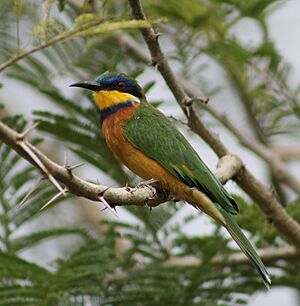Ethiopian bee-eater facts for kids
Quick facts for kids Ethiopian bee-eater |
|
|---|---|
 |
|
| Conservation status | |
| Scientific classification | |
| Genus: |
Merops
|
| Species: |
lafresnayii
|
The Ethiopian bee-eater (Merops lafresnayii) is a colorful bird that belongs to the bee-eater family, called Meropidae. You can find these birds mainly in Ethiopia and Sudan. It used to be thought of as a type of blue-breasted bee-eater, but now it's its own species.
This bee-eater lives in rainforests. It often sits alone on a high branch in the treetops. From there, it watches for small insects like butterflies and honeybees. When it spots one, it quickly swoops down to catch it. Then, it flies right back to its perch.
Scientists know where these birds live, but they don't know much about their mating habits. They prefer places with lots of rain and humidity. These areas are mostly in the rainforests of southwestern Ethiopia and parts of Sudan. The exact number of Ethiopian bee-eaters is not known. However, their population seems stable. There are no big threats to them right now. Because of this, the International Union for Conservation of Nature and Natural Resources (IUCN) says they are a species of "Least Concern." This means they are not in danger.
Contents
What Does the Ethiopian Bee-Eater Look Like?
The Ethiopian bee-eater is a very pretty bird. Its back feathers are green. Its belly is a reddish-brown color, which is called russet. It has a bright yellow throat. Around its head, eyes, and across its chest, there is a dark blue band.
When the bird flies, you can see more colors. There's a black stripe and more russet feathers under its back. These colors are also on the underside of its wings. From above, its wing feathers look yellowish-brown near its body. They become a bright blue color closer to the wing tips. There is also a black stripe along the back edge of its wings.
What Do Ethiopian Bee-Eaters Eat?
Ethiopian bee-eaters are insectivorous, meaning they eat insects. Their diet is mostly made up of flying bugs. This includes butterflies, dragonflies, moths, large beetles, and of course, bees.
These birds use two main ways to hunt. Sometimes, they fly quickly between shrubs and low tree branches to grab insects. Other times, they slowly fly down from their resting spot. They might hover in the air for a moment before catching their prey. After catching a meal, they fly back to their perch. They hold the insect at the tip of their beak. Then, they hit it against a branch many times to make sure it's dead before eating it.
How Do Ethiopian Bee-Eaters Behave?
Ethiopian bee-eaters act much like other birds in the Meropidae family. They are both gregarious and diurnal. "Gregarious" means they like to be in groups. "Diurnal" means they are active during the day.
You can often see them gathering in large groups. During mating season, they set up special areas for their nests. These areas are usually about 2 kilometers away from where the flock finds food. In these nesting spots, bee-eaters feel safe. They use this safety to spend time with other birds from nearby nests. They also preen their feathers. This means they clean and smooth their feathers. They expose their feathers to sunlight and take dust baths. This helps them prevent tiny bugs from living on their bodies.
Nest and Reproduction
Ethiopian bee-eaters build their nests by digging tunnels. They dig these horizontal tunnels into vertical walls, like a riverbank. At the end of the tunnel, there's a wider, oval-shaped space. This is where they keep their eggs.
They lay eggs only once a year. Each time, a female bee-eater usually lays about 5 eggs.


